When it comes to board games, I am not a lucky individual.
Luck mitigation is not my forte at the dining room table. Just ask my children. I am willing, however, to play games that demonstrate my near-constant misfortune. Unless, of course, that game repeatedly pours me into a spiral of endless frustration that makes me want to carry the little pouch of potion ingredients to the attic so that I can launch it out the window in twisted glee. Where’s your cherry bomb now, Quacks?!
But I digress. The emotional consequences of pushing my luck one too many times will have to wait for another day.
Dice Forge is, to an extent, a game of luck. Any game that relies almost exclusively on rolling dice must be, right? Yet there is something that the folks at Libellud got right in making this fidgety dice-morphing gem that frees me from the mental anguish I typically experience when I must relinquish my self-determined destiny, often on my way toward crushing defeat.
Régis Bonnessée (Seasons, Himalaya, Lords of Xidit) is not the first designer to introduce the ability to alter dice. However, Dice Forge succeeds in utilizing this enjoyable mechanism as the main dish amid a healthy buffet of strategic choices in a game that never quite feels as if it’s merely a game of chance.
The gods, after all, are not known to play with dice. (But if you are, check out our Dice-Rolling Top Six or these Dice-Rolling Euros!)
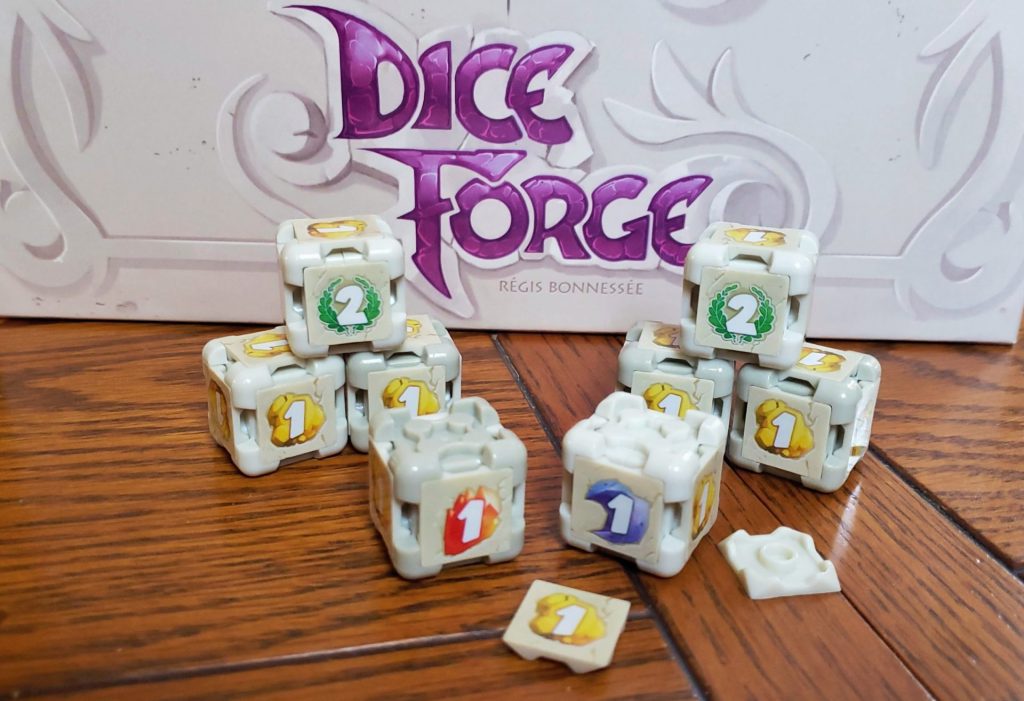
Enter the Tournament
The arena for this divine competition is divided into two areas. The game box, having been emptied of its various components, transforms into the Temple. Consisting of a sanctuary and a garden, this high ground is where heroes will present offerings of gold to the gods in order to obtain more potent die faces and subsequent divine blessings.
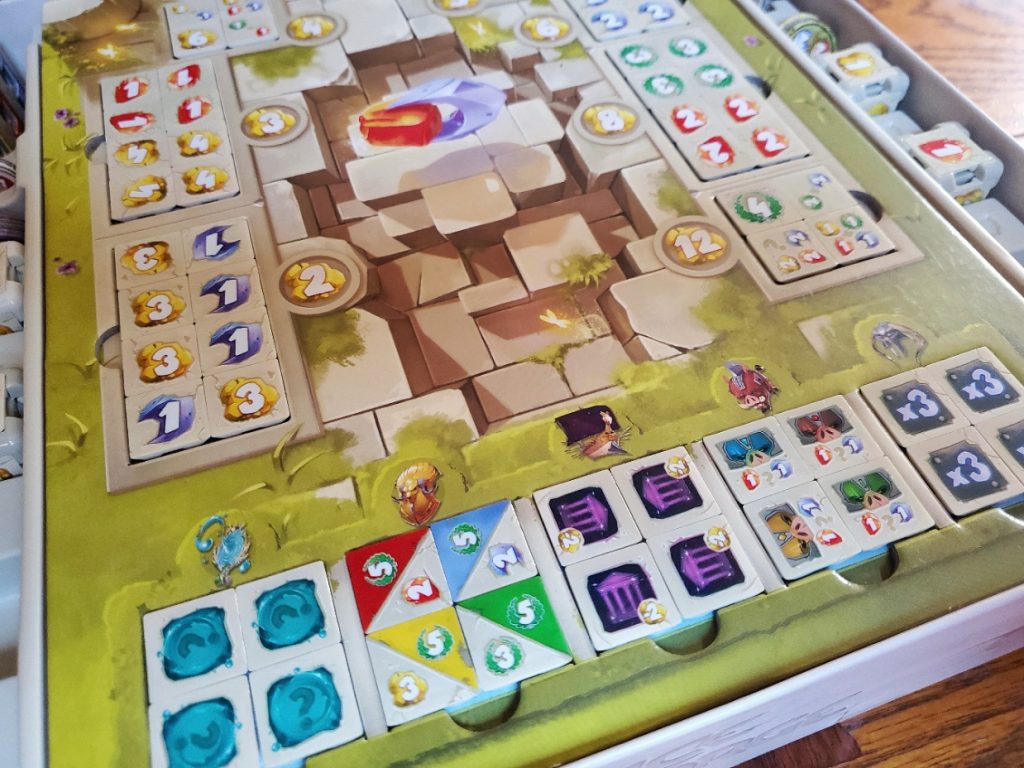
The Islands, then, are found on the game board, whose card-grasping shape could only be fittingly captured by adjectivizing the name of an insect. Centipedinal? Scutigeral? The arthropodal board consists of heavenward real estate – sky islands – connected by mystic portals where the heroes acquire cards of ancient relics to aid their glorious quest.

All epic storytelling aside, setting up Dice Forge will take a few minutes. For the first-time player, specific cards are marked for use on the Islands. For the more familiar gaming group, setup involves discussing, deciding, drafting, or randomly dealing which relics to include. This gives the game great variety, but also a certain amount of sifting through components at the outset.
Along with their colored pieces, players receive a hero inventory board during setup along with several colored cubes to track the gathering of gold, along with sun shards, moon shards, and coveted glory points. These resources form the currency of the divine tournament. A certain amount of gold goes to each player before the first turn. Finally, each player holds out an eager hand to receive those fabled dice, forged to the base configuration.

Gameplay is rhythmic. On each player’s turn, all players roll their dice and accumulate the spoils of the divine blessing—gold and shards. The active player then checks their relics for any recurring reinforcements, which come from cards with perpetual abilities, before performing one of two actions:
- Heroes may visit the Temple to spend their gold as an offering in order to acquire any number of new die faces. Players then forge these faces to be employed in future rolls.
- Otherwise, they may visit the Islands to spend sun shards or moon shards to acquire valuable relics that trigger assorted abilities and bank glory points. If one hero ousts another from their location in the process, the bumped player receives a divine blessing (a free roll of both dice) as compensation for the obvious inconvenience.
In either case, players may also spend excess sun shards in order to acquire an additional action of their choosing – a costly endeavor, but a lucrative one when well-timed.
Play continues in this manner for the established number of rounds, after which the tournament ends, glory points are tallied, and a winner is ushered into their new position as a demigod. (Accoutrements for the celestial ceremony not included)
The Role of the Dice
These chunky dice are just plain fun in hand. They are notably larger than typical dice, but they roll beautifully. Each newly acquired face serves as the physical tool for the removal of the discarded faces. They are quite easy to manipulate. Faces are stored in a layered cardboard tray that holds various combinations in “pools,” allowing for easy access and easy (even if time-consuming) organization. The tray is also stored in a banded sleeve that shows a diagram of the loaded pools and holds everything in place. In short, as a component, they are a delight from start to finish.
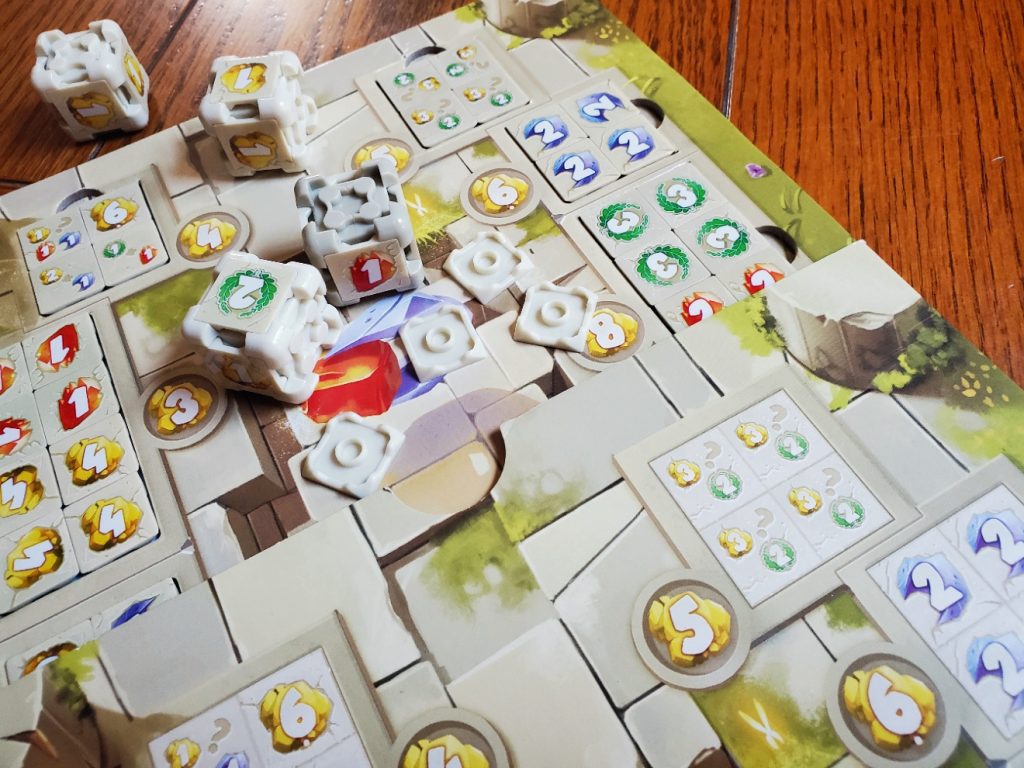
But what about the luck factor?
While luck is certainly an element of the game, the need for good luck decreases with each passing round. Sparse gold, covering 75% of initial configuration, is the expected fruit of early rolls. That gold is then quickly transitioned into more lucrative and strategic faces which further enable the purchase of relics, which really are the ultimate offset to the whims of chance. The wealth of decision-making in the transition from the Temple to the Islands is where the tournament is won and lost, which means ultimate outcomes do not hang entirely on the fountain of fidgety fortune flowing forth from forged dice.
This means that the thirty-plus rolls of the super-cool dice elicit increasing joy and decreasing frustration. What a gift!
Dealing With the Cards
The relics of Dice Forge, and the particular sky islands to which they belong, are distinguished by their cost in either sun shards or moon shards. There are multiple card options in the box for each value on the board. With 15 cards in play for a given outing, this allows for ever-changing combinations and strategic possibilities from session to session.
The cards are nearly universally positive – true blessings rather than vicious attacks, keeping the mood of the tournament fairly light. There are cards that trigger immediately, cards that trigger perpetually, and cards that linger with grandeur reserved for the endgame. There are cards that bolster your resource capacity, cards that multiply your production, and cards that enable you to mooch a bit of luck from your opponent who seems to roll no wrong. In short, there are enough tactical options to make any number of strategies worthwhile.
Quite often, the cards allow the hero to forge an exciting and unique die face, but the size of the die face means reducing all of the game’s communication to symbols. As is the case in so many games, the wide-ranging symbology brings a hefty learning curve. The game boasts a slew of flames, swirls, hammers, stones, creepy eyes, pig noses, mirrors, and question marks along the path to total victory. Thankfully, the rules contain a separate insert as a reference to the symbology of the cards and dice, which is a great help until the various options become clear. And they do become clear.
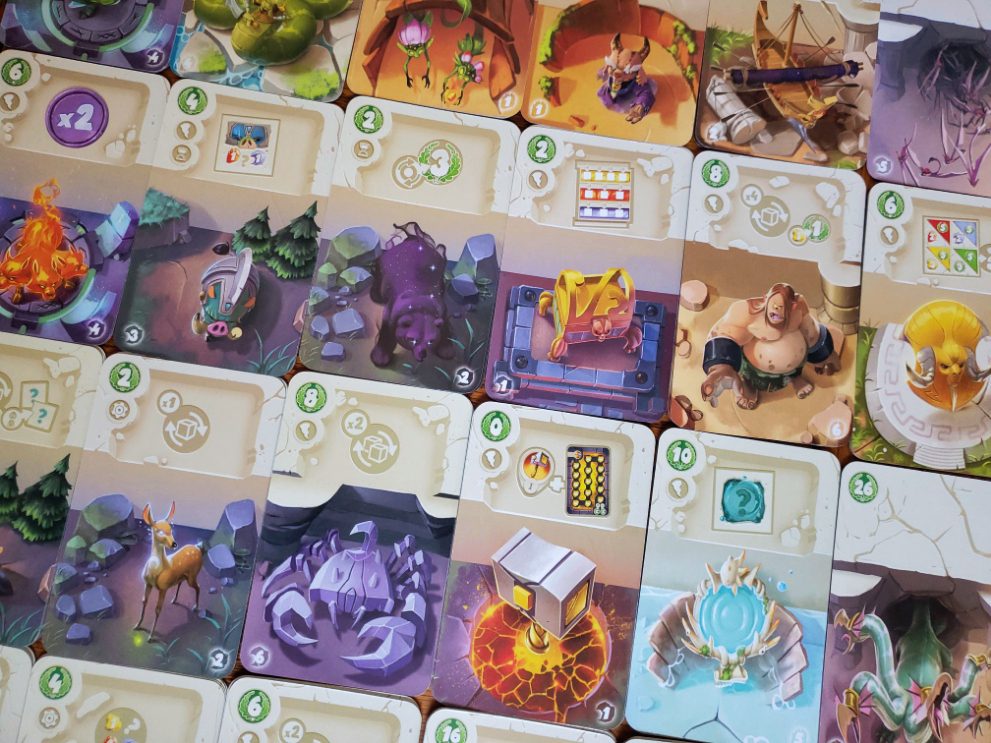
The Reckoning
Dice Forge is one of the first games in our collection that excited one of my children enough to purchase it from the shelf at an FLGS with his own money. The concept is appealing in that way. It is a game that rarely fails to draw folks to the table, even if just out of curiosity about the dice.
That curiosity then opens the door to a fun experience. We have a blast playing this game. (We’ve since picked up the Rebellion expansion, an offering worthy of its own review for its abundant card count, complementary mechanics, and single mega-die.) I love the fact that my youngest (8 yrs old) can get excited about every trip to the Temple as if he were skipping to a candy store, and yet still compete on some level. In fact, one child or another often wins. There is approachable depth here.
No matter the outcome, though, Dice Forge is not the kind of game you complain about when the dice haven’t gone your way. Half the fun is in the way the game’s implements were picked apart, re-shaped and guided by your choices. And so the game ends, you admire the dice as you disassemble and gather the pieces.
Regarding that post-game, though: For all the time poured into setup, there is equal time required for tear down. Every face must be popped and returned to its rightful home. Every card must be sorted and returned to its well-organized place in the deck. However, since the strength of this particular game lies in the many ways you get to fidget and fuss over the vast inventory of plastic and cardboard, a bit of clean-up is to be expected.
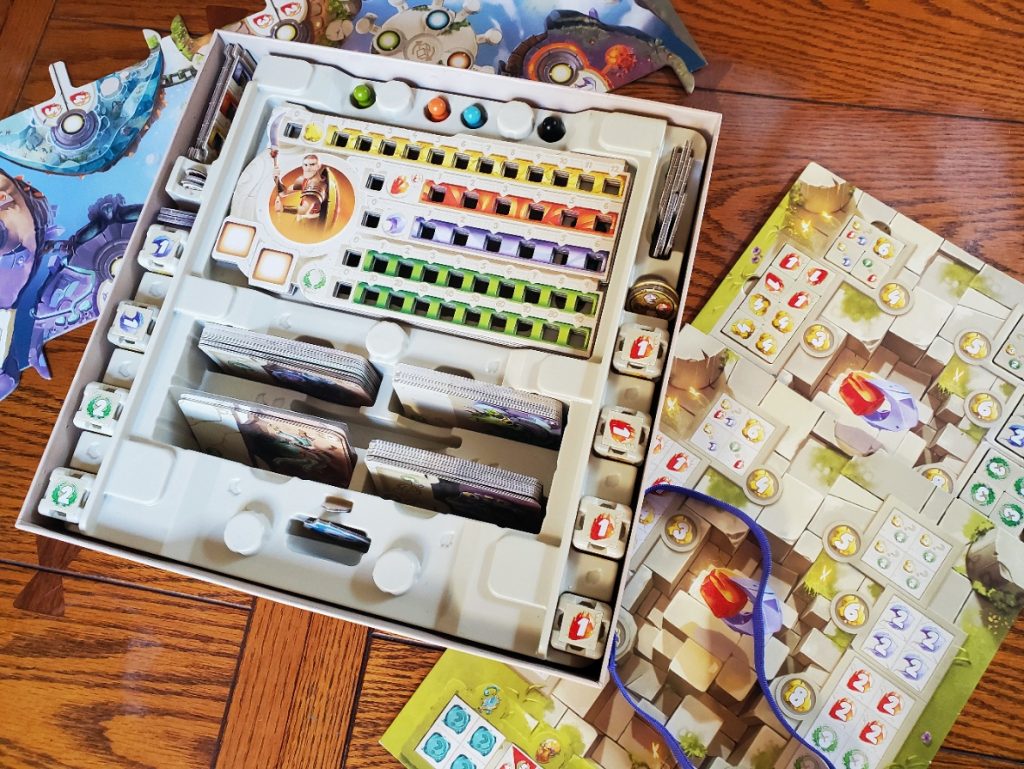
Overall, I consider Dice Forge a divine contest worthy of exploration. The rules adequately account for two to four players, making the game equally engaging at any count. Biboun (Deep Blue, Time Bomb: Evolution) has illustrated a colorful world to match the engaging mechanics and the somewhat interactive play. The game certainly has a memorable presence on the table. It’s light enough to rally the family, but thoughtful enough that you could go all in on decision-making with a group of gamers.
In this guy’s opinion, it’s worth a roll of the dice if you get a chance.
One year later…
Dice Forge is still at hit at our table today. In fact, we recently taught our youngest (nearly five as of this writing) to join us for the adventure and she took to the game almost instantly! The joy of rolling those chunky dice, along with the popping and setting of new faces have made this a highly requested title of late. Most often, we employ the Rebellion expansion, specifically the Goddess module. We’ve found it provides manageable bonuses without forcing the attention away from the core mechanics. I can’t imagine this one leaving our collection. It has become an ingrained fixture across the generations.


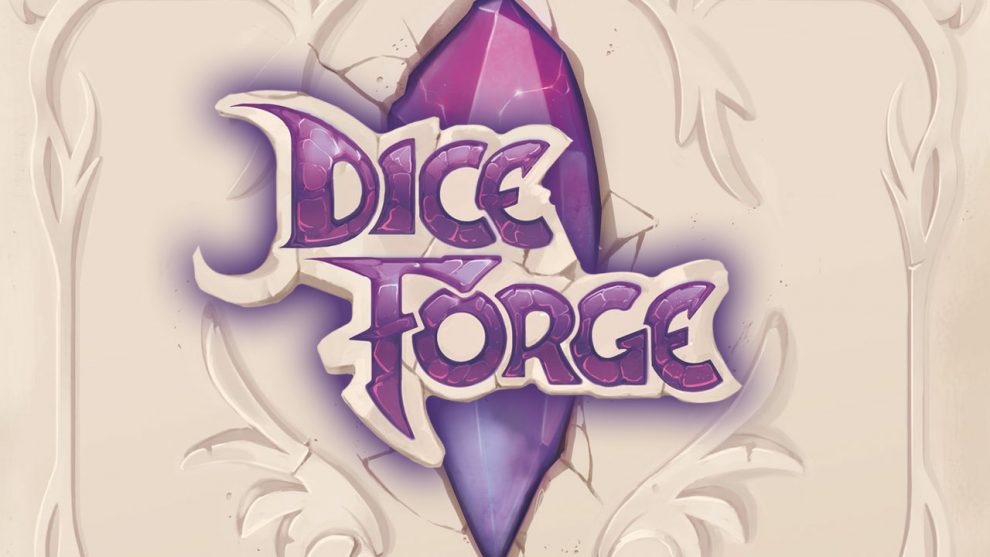




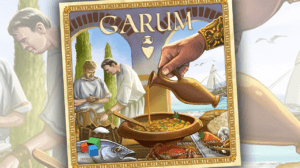




Excellent review! Thanks!
I’m glad you enjoyed the review! It’s certainly a beloved title in our home.
Excellent review and particularly like the revisit a year later. More reviewers should do that
Thank you Alex for the kind words. I will try to keep up with the good habit! Some of the writers here have done it in the past and I wanted to join that club. I hope you’re able to find as much joy in Dice Forge as we have.